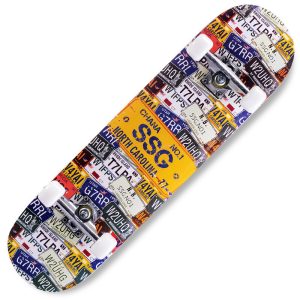
How to Kickflip – Kickflip Trick Tips
How to Kickflip – Kickflip Trick Tips Mastering the kickflip is a pivotal moment for any skateboarder, marking a transition from beginner to
Planning a camping road trip doesn’t need to be daunting. In fact, camping is one of the simplest (and cost-effective) ways to enjoy the open road. The ribbon of asphalt gives way to smooth dirt roads that lead you into the heart of the wilderness.
The key to a successful camping road trip is careful planning, budgeting, and allowing for flexibility. You want space to accommodate the unexpected. Plan for days of inclement weather and know when to take breaks.
I engage in at least 12 road camping trips annually. It’s actually one of my favorite ways to embrace the outdoors.
Over the years, I’ve honed the art of adeptly planning camping road trips. From where to go to what to bring, we provide you with expert advice.
Learn from my headaches and mishaps, so you can plan the ultimate camping road trip.
Outdoor Survival Camping Equipment Set
In this guide to planning camping road trips, you will receive expert advice from seasoned professionals. As a freelance writer, I have indeed been rewarded through outdoor camping road trips. Over the years, I’ve learned a thing or two. Inside, you will find the following content:
Comprehensive Checklist of Top Camping Tips
Before hitting the road, it’s crucial to have your route planned out. When plotting the right course for your camping road trip, you need to be savvy with the basics. Start with how long you’re willing to drive each day.
Of course, you’ll come across interesting sights along the way, but keep in mind that consecutive heavy driving days can leave you exhausted with limited time for exploration.
One of my favorite camping tips is to venture as far as possible from home on the first day. This allows you to wrap up those long driving stretches while you’re still energized.
Next, Slow Down. Plan multiple days of stopping or move only for an hour or two each day. This will allow you to maximize your time for hiking, exploring, and adventuring.
Take your time on the way back home, stopping as often as you’d like. Be sure to plan ahead for any reservations (popular attractions, rentals, must-see sunrise spots, hiking/backpacking permits, campgrounds, etc.).
Balance scheduled activities with flexibility during the middle days. This will help you avoid feeling constantly on the go and give you time for adventure to come your way.
Before leaving home, download offline maps (on Google Maps, click on your profile picture, choose Offline Maps, then select the area you want to download). Now you can navigate without phone service.
Save all scattered campsites (detailed later) as “Saved places” on the map for easy reference.
Lastly, record all routes and upload them to your GPS. Use your phone or a separate device. Now your adventure is set and you’re ready to embark on the journey of a lifetime.
Now, it’s time to crunch the numbers for your budget. Camping road trips are budget-friendly adventures. However, assuming you won’t spend money on the road is unrealistic. In reality, your expenses could surpass your initial estimates.
While many use apps for this task, I lean towards a digital minimalist approach and find budgeting quick and hassle-free. Here’s a simplified method:
In brief – no. If apps can assist in planning and managing your trip, feel free to leverage them. Yet, to be honest, over the past ten years of road camping, I’ve mainly relied on GPS and Google Maps without relying heavily on other apps.
I discover a sense of incredible freedom when I leave my phone behind. If you’re looking for a hiatus, think about jotting down your route in a Google Doc (download it for offline access) and rely solely on map apps for navigation.
Alternatively, embrace a bold approach and embark on a genuine adventure without any technological aids.
Before hitting the road, give your vehicle a thorough inspection. When was your last oil change? Is your windshield wiper fluid topped off? How’s the condition of your tire treads? Assess your fluid levels.
Address any necessary replacements or repairs before hitting the road. You’ll be thankful – there’s nothing worse for a camping road trip than unexpected car issues!
Here’s a camping road trip tip – consider planning a night or two in a hotel. Personally, I find it rewarding to schedule hotel or Airbnb stays for a few nights during the journey.
Why? Because occasionally, we all need a break from camping. There are times when you simply crave some indoor space to stretch out and relax.
Additionally, if you have the budget and encounter unfavorable weather conditions, you don’t have to endure sleeping in mud, snow, or strong winds. (I’ve been there… many times.)
The essence of a camping road trip is to savor enjoyment. So, even if you plan to camp throughout, it’s wise to reserve some funds for occasional hotel stays. This way, you can steer clear of harsh weather and still find pleasure rather than discomfort.
I frequently embark on camping road trips with my tear-drop camper, estimating I can go for around 4 to 5 nights before needing an indoor break. During these stops, I refuel, tidy up, do laundry, fill up the water tank (most truck stops are accommodating if you ask politely), and then set off again.

How to Kickflip – Kickflip Trick Tips Mastering the kickflip is a pivotal moment for any skateboarder, marking a transition from beginner to

How to Put on Knee Pads for Work When working outdoors or participating in sports, protecting your knees is essential. Quality knee pads not

UNDERSTANDING FISH HOOK SIZES Mastering the art of reading fishing hook sizes is a simple yet crucial skill. It boils down to one key factor:

PICKING THE PERFECT FISHING REEL Understanding the various types of fishing reels is easier than you might think. While there’s a wide array of options